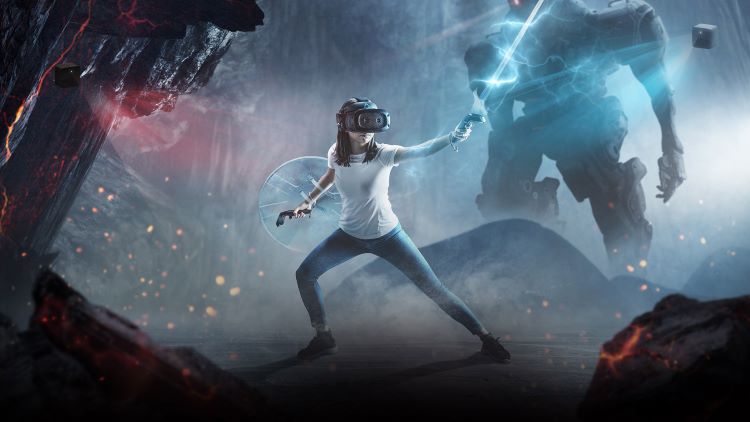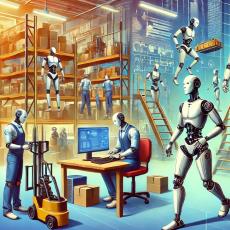Artificial Intelligence (AI) is transforming the gaming industry, revolutionizing the way games are created, played, and experienced. From hyper-realistic graphics to smarter NPCs (non-playable characters), AI is pushing the boundaries of what’s possible in gaming.

Here’s a deep dive into how AI is shaping the future of gaming.
1. Smarter Non-Playable Characters (NPCs)
In current games, NPCs still follow predictable and repetitive patterns, often performing the same actions regardless of the player's behavior, and sometimes they perform in ways that seem irrational and funny. For example, NPC cars in Grand Theft Auto V (GTA V) can drive off an overpass when blocked by a bus, this highlights even in the most advanced open-world games, NPCs still struggles with basic navigation and decision-making.

With AI, however, developers can create NPCs that adapt to player actions, making them more intelligent and realistic.
- Adaptive Behavior: AI allows NPCs to learn from player strategies and adapt their tactics, creating a dynamic and challenging experience that feels unique every time. Players can now face NPCs who react in ways that mimic human intelligence, rather than simply following a fixed script.
- Realistic Interactions: AI-driven NPCs can engage in more natural and varied conversations, improving immersion and emotional engagement. While AI has made remarkable strides, the ultimate goal remains for NPCs to exhibit behaviors that are as nuanced and believable as a real person.
2. Procedural Content Generation: Infinite Worlds and Custom Experiences
One of the most groundbreaking applications of AI is procedural content generation (PCG), which allows games to create vast, complex worlds automatically. Games like No Man’s Sky and Minecraft have used PCG to offer players endless exploration, creating an unprecedented level of scale in video game environments.

- Endless Exploration: Most of the games nowadays have map restrictions. For example, the map of GTA V is an island of about 80 square kilometers. Although the terrain and cityscape of the island are based on Los Angeles in the real world, the area is far smaller than Los Angeles. Exploring this small island for a long time will make players feel bored. By contrast, AI algorithms can generate diverse terrains, ecosystems, and cities automatically, allowing players to explore virtually infinite worlds without running out of content.
- Personalized Gameplay: Today's 3A games all have set plots, and all players have to go through the same story. AI can tailor content based on player preferences and behavior, ensuring each experience is unique. Whether it’s generating new levels, quests, or story arcs, AI can ensure no two playthroughs are ever the same.
3. Streamlining Development with AI-Assisted Tools
AI is not only reshaping the player experience but also transforming the development process itself. Game developers can now leverage AI-powered tools to speed up production and improve the quality of games.
- AI for Animation and Design: With AI, complex character animations, lifelike physics simulations, and even entire game worlds can be generated automatically. This reduces the workload for designers and animators, allowing them to focus on creativity and fine-tuning.
- Automated Testing and Optimization: AI can help identify bugs, test game mechanics, and optimize performance far more efficiently than traditional methods. This is particularly beneficial in large-scale games where manual testing can become prohibitively time-consuming.
4. Immersive Graphics and Realism Powered by Deep Learning
In the realm of graphics and visual fidelity, AI is enabling real-time advancements that were once considered impossible. Deep learning models, like those used for image upscaling and lighting, are now able to transform even the most basic game into a visually stunning experience.
- AI for Real-Time Graphics Enhancement: AI can upscale lower-resolution textures in real time, improve lighting and shadows, and simulate realistic environments, all of which contribute to a richer, more immersive gaming experience.
- Hyper-Realistic Physics: AI also helps simulate natural phenomena, such as fluid dynamics, weather systems, and particle effects, making the world feel alive and reactive.
5. AI-Driven Personalization: Tailoring Gaming to the Individual
AI offers the potential to tailor gaming experiences to individual players, making games more engaging, accessible, and satisfying.
- Dynamic Difficulty Adjustment: AI can monitor a player’s performance and automatically adjust difficulty levels to ensure a challenging yet fair experience. This prevents frustration while maintaining excitement and engagement.
- Personalized In-Game Experiences: AI can suggest new content, character upgrades, and even in-game purchases that align with a player’s behavior, offering a more customized journey through the game.
6. Revolutionizing Multiplayer and E-Sports
In multiplayer games, AI is enhancing player matchmaking, improving anti-cheat systems, and even providing coaching to help players refine their skills.
- Smarter Matchmaking: AI analyzes players' skill levels, behavior, and playstyle to create fairer and more competitive matchups. This ensures that players are matched with others who offer the right level of challenge, enhancing the overall multiplayer experience.
- AI Coaching and Analytics: In competitive gaming, AI can offer real-time coaching, helping players improve by analyzing their gameplay and providing insights into better strategies, positioning, and decision-making.
7. AI and Virtual Reality: A New Level of Immersion
AI is playing a key role in the next generation of virtual reality (VR) and augmented reality (AR) gaming, creating worlds that react to players in real time.
- Real-Time Interaction in VR/AR: AI enables games to dynamically adjust to a player’s actions, movements, and decisions, making VR/AR experiences more immersive and responsive.
- AI-Driven NPCs in VR: In VR games, AI allows NPCs to interact with players in ways that feel more natural, with realistic body language, facial expressions, and dialogue. This heightens the sense of presence and emotional connection in virtual worlds.

8. Revolutionizing Storytelling Through AI
Storytelling has always been at the heart of great games, and AI is helping to push the boundaries of narrative design. AI-driven systems allow for more fluid, adaptive stories that respond to player choices and actions.
- Dynamic, Branching Narratives: AI can create storylines that adapt to player decisions, offering branching paths and multiple endings. This creates a personalized narrative that encourages replayability and deepens the emotional impact.
- Natural Dialogue Systems: AI-powered dialogue systems allow players to engage in meaningful conversations with NPCs, making interactions more fluid and immersive. Advanced natural language processing (NLP) allows for a level of depth and realism previously unimaginable in gaming.
Conclusion
AI is revolutionizing the gaming industry, offering unparalleled innovation in gameplay, design, and player experience. As AI technology continues to evolve, we can expect even more groundbreaking advancements that blur the line between virtual and reality. For players and developers alike, the future of gaming with AI is boundless and exciting.
Whether you're a casual gamer or a hardcore enthusiast, AI is shaping a future where games are smarter, more immersive, and endlessly entertaining.





